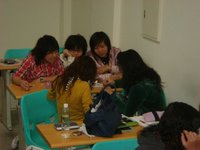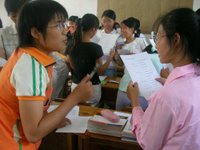 The way the students are seated in the classroom will often determine the dynamics of the lesson. We’ve already seen in a previous article how a simple change in the seating pattern can make an incredible difference to group coherence and student satisfaction, and I’ve seen many other cases where seating has been a crucial element in the success or failure of the lesson.
The way the students are seated in the classroom will often determine the dynamics of the lesson. We’ve already seen in a previous article how a simple change in the seating pattern can make an incredible difference to group coherence and student satisfaction, and I’ve seen many other cases where seating has been a crucial element in the success or failure of the lesson.The seating pattern you use may, in some cases, not be fully under your control – if for example the desks are fixed to the ground or the school has strict rules about not moving the furniture. Student numbers are also going to be an issue – EFL groups can be anything from one student to four hundred. However, except in extreme situations, some degree of choice is usually possible.
 For the moment I’ll talk about average size classes – anything from 6 to 25. Teachers have different preferences for seating arrangements – groups seated round small tables is often one. This is probably the best option for the larger classes in this range, but for smaller numbers and with adult or teenage students I prefer the horseshoe shape, which I find has all of the advantages of groups, and none of the disadvantages. A horseshoe may be desks in a U-shape with a hollow centre, students in a semicircle on chairs with arm-rests and no desks, or students seated around three sides of a large table, with the teacher at one end.
For the moment I’ll talk about average size classes – anything from 6 to 25. Teachers have different preferences for seating arrangements – groups seated round small tables is often one. This is probably the best option for the larger classes in this range, but for smaller numbers and with adult or teenage students I prefer the horseshoe shape, which I find has all of the advantages of groups, and none of the disadvantages. A horseshoe may be desks in a U-shape with a hollow centre, students in a semicircle on chairs with arm-rests and no desks, or students seated around three sides of a large table, with the teacher at one end. In any case, whatever seating pattern you choose or is imposed on you, the class is likely to be more successful if you keep the following principles in mind :
- Try and maximise eye contact – both teacher to student and student to student. In full class phases of the lesson, if the person who is speaking does not have eye contact with the others, then attention is likely to drop. This is the main reason I personally prefer the horseshoe shape to groups – when students are seated around separate tables, some inevitably have their backs turned to each other and/or to me. This makes it much harder to keep the full attention of the class during phases such as explanation or instructions, or when other students are speaking to the group. If students are in groups, make sure they are turned towards you before you start a full-class phase. Be careful also that you don't lose the group's attention and let pace drop if you are speaking not to the group as a whole, but to one particular student. If it has to be more than a couple of sentences, again make sure the students' are focused on the person who is speaking.
- Make sure students are seated at a comfortable distance from each other. Large distances between the students will tend to lead to a “muted” atmosphere, low pace, and less active student participation in the lesson. This is particularly important if you are teaching a small number of students in a class set up for more. If for instance you have a group of seven in a room set up with twelve seats round three tables, don’t leave a large space between the groups, or between yourself and the groups. Try and arrange things so that the “empty space” is behind students, where they’re less aware of it, divide the students 3-2-2 between all three tables, or use just two adjacent tables - those closest to you. And make sure you don’t have one student sitting alone, outside the groups.
- Think in advance about how you will organise changing partners or changing groups. This is a stage of the lesson which can potentially descend into chaos if it’s not tightly controlled, with students wandering aimlessly around not knowing where to go or confidently moving to the wrong place. It’s better to find a method that works and stick to it – that way the students get used to it, know exactly what to do, and changes go smoothly. Again, the horseshoe shape makes changing partner easy - label the students ABABAB around the horseshoe, then ask all the As to stand up and move to the empty seat on their left (the person at the end on the right side moves to the first seat on the left). If they are in groups, much the same technique is possible. For example, if they are working in threes, label them A,B and C – Ask all the As to stand up and move one chair to their left, wait until they’ve arrived so as to avoid confusion, and then ask all the Bs to stand up and move one seat to their right. They then end up with completely different partners.
 What do you do if you’re working with students seated in rows, possibly with desks fixed to the ground? In a typical classroom set-up, alternate rows can be asked to turn their chairs around in order form groups with the people sitting behind. Or they can be asked to stand up and do the activity on their feet, moving around as necessary. In a lecture theatre type arrangement however, very often it is not only the benches but also the seats which are fixed, and the students are “trapped” inside the rows. In this case, change pairwork partners by a
What do you do if you’re working with students seated in rows, possibly with desks fixed to the ground? In a typical classroom set-up, alternate rows can be asked to turn their chairs around in order form groups with the people sitting behind. Or they can be asked to stand up and do the activity on their feet, moving around as necessary. In a lecture theatre type arrangement however, very often it is not only the benches but also the seats which are fixed, and the students are “trapped” inside the rows. In this case, change pairwork partners by a sking the person at the far end of each row to stand up, and the whole row to move one seat to the right. The person standing then moves round to the empty seat on the far left, and new pairs can be formed.
sking the person at the far end of each row to stand up, and the whole row to move one seat to the right. The person standing then moves round to the empty seat on the far left, and new pairs can be formed.
So far I've talked about the teacher deciding, but what about students' preferences? Should they be taken into consideration?
Bear in mind that students often prefer what they are used to and will resist change. If they have always sat in one position, they will have established a psychological "territory". The room will feel right from that position, and they may feel uneasy in another. This is why I suggested in an earlier article that the first lessons with a class are often crucial - if the students get used to the seating pattern that the teacher has chosen, or to changing seats frequently, from the beginning they are much less likely to resist than if a change is made half way through the course.
Whether students choose their own position or not will also depend on the reason. One student may not want to sit near the window because of draughts for instance, or as close as possible to the board because of sight problems. The teacher needs to be aware of these factors and take them into consideration. However, the most common reason for choosing or avoiding a seat is often who their neighbours are, and this - who do they sit with? - is something that can have an important effect on the success or otherwise of the class. It's a question that deserves to be considered at length and is something we'll look at in the near future.
Acknowledgements
No comments:
Post a Comment